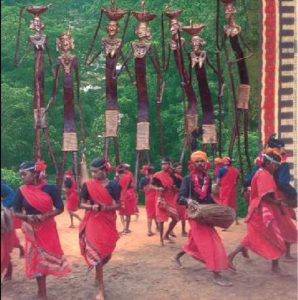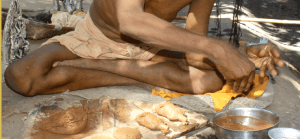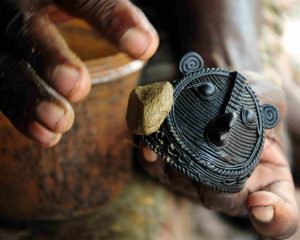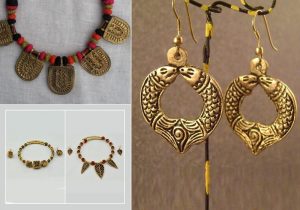The Dhokra style of handicraft is a unique method of creating figurines and objects out of a non-iron metal casting which is practiced in India. Origin of this art form has been traced to the ancient era of Indus Valley civilization, where the statue of the ‘Dancing Girl’ was excavated and found to be made up of the same lost wax metal casting as used in Dhokra handicraft items. In the ancient world, many countries like China, Central America, Nigeria and Egypt practiced this art form but it has remained intact only in India at present.
In West Bengal, this art form is still the primary livelihood for the Dhokra Damar tribes who are named after the resin of the Damara orientalis tree, an essential ingredient of the wax used in making the objects. The figures are unique and the tribes have used them for centuries to narrate the sagas and local legends, long before paintings and writing became the formal modes of communication.
Before beginning the process, the tribal men and women pray to Tvastra, the third son of Lord Vishwakarma, who is believed to be an expert in metal casting works. Then they begin the process:
A mixture of clay and rice husk is used to make the core of the item.
Wax, resins of Damara tree and nut oil are used to make a soft dough. The soft wax is now passed through a sieve and rolled into long strands which give the characteristic rolling patterns in the Dhokra items.
It is then layered upon the core to sculpt in fine details and embellishments.
Red soil and rice husk mould are anointed upon the figure and a hole is made through center to provide a freeway for inner molten wax.
After sun-drying and burning in the traditional chulhas, the wax comes out of the mould and metal is poured in through the holes made earlier.
After cooling, the mould is chipped away and an original metal figure is revealed from underneath it.
A few of the most common figures are that of women carrying pots or logs, dancing couples, animal figures and different postures of gods and goddesses of Hindu mythology.
Recently, jewellery made of Dhokra has become quite popular and helped in expanding the market of these items. In spite of the crude process of manufacture, the objects are finely crafted and have intricate details carved upon them, starting from clothes to the jewellery designs in female figurines.
It is tragic to note that the Dhokra craftsmen are on a decline as people nowadays prefer machine manufactured cheap goods, ignoring the charm and ethnicity of such beautiful craft forms spread all over India. The young men of the tribes have migrated away and some still remain embroiled in this tradition, hoping to reignite the interests of consumers by their work and take it to the high level of popularity which it had once garnered.
-Ruchira Dhar






